Deck 11: Parental Care
Question
Question
Question
Question
Question
Question
Question
Question
Question
Question
Question
Question
Question
Question
Question
Question
Question
Question
Question
Question
Question
Question

Unlock Deck
Sign up to unlock the cards in this deck!
Unlock Deck
Unlock Deck
1/22
Play
Full screen (f)
Deck 11: Parental Care
1
In what sense is the male hangingfly's gift of a fly to his mate rather like parental investment, even if the female does not use the fly to help her produce larger or better eggs?
A) The time and energy spent capturing the gift reduce the male's future potential reproductive output.
B) The gift may be used to increase the number of eggs the female produces.
C) The gift makes it more likely that that male will have offspring in the future.
D) The consumption of the fly means the female may live longer, just as parental investment results in parents living longer.
A) The time and energy spent capturing the gift reduce the male's future potential reproductive output.
B) The gift may be used to increase the number of eggs the female produces.
C) The gift makes it more likely that that male will have offspring in the future.
D) The consumption of the fly means the female may live longer, just as parental investment results in parents living longer.
A
2
The Trivers-Willard hypothesis primarily attempts to explain
A) variation in the sex ratio of offspring.
B) parent-offspring conflict.
C) siblicide and infanticide.
D) the decline in reproductive output with age.
A) variation in the sex ratio of offspring.
B) parent-offspring conflict.
C) siblicide and infanticide.
D) the decline in reproductive output with age.
A
3
Ghalambor and Martin (2001) found that a North American species of thrush placed higher value on their current nest full of offspring than did a similar South American species. This differential response is due to
A) a more abundant food supply in North America.
B) South American birds generally living longer than those in North America.
C) South American birds generally laying only one egg per nest.
D) higher parasitism rates in North America.
A) a more abundant food supply in North America.
B) South American birds generally living longer than those in North America.
C) South American birds generally laying only one egg per nest.
D) higher parasitism rates in North America.
B
4
Why do birds make a good group for the study of parental care?
A) Polyandry is extremely rare in birds.
B) They are found on every continent.
C) Both sexes are able to provide for their young.
D) They don't discriminate against their offspring.
A) Polyandry is extremely rare in birds.
B) They are found on every continent.
C) Both sexes are able to provide for their young.
D) They don't discriminate against their offspring.

Unlock Deck
Unlock for access to all 22 flashcards in this deck.
Unlock Deck
k this deck
5
Refer to the figure.
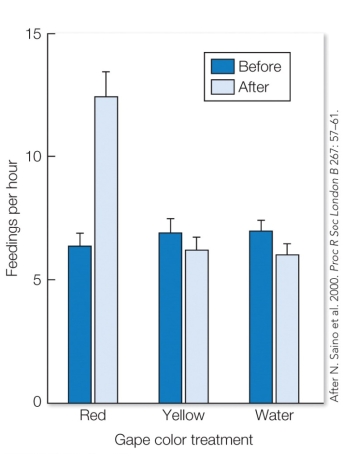 These results indicate that
These results indicate that
A) chicks with colored gapes received more food than those with an unaltered gape.
B) chicks with gapes colored red received more food than those with a yellow or unaltered gape.
C) experimentally altering chicks' gapes reduced the amount of food that they received.
D) experimentally altering chicks' gapes did not impact the amount of food they received.
 These results indicate that
These results indicate thatA) chicks with colored gapes received more food than those with an unaltered gape.
B) chicks with gapes colored red received more food than those with a yellow or unaltered gape.
C) experimentally altering chicks' gapes reduced the amount of food that they received.
D) experimentally altering chicks' gapes did not impact the amount of food they received.

Unlock Deck
Unlock for access to all 22 flashcards in this deck.
Unlock Deck
k this deck
6
Refer to the figure.
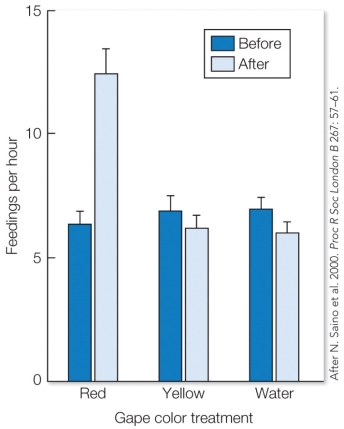 If natural gape coloring is dietary, this experiment was most likely to test the prediction that
If natural gape coloring is dietary, this experiment was most likely to test the prediction that
A) parents preferentially feed offspring with bright red mouths because they are investing in nestlings of high reproductive value.
B) parents preferentially feed offspring with bright red mouths because they use this as signature to recognize the chicks as their own.
C) parents in low quality habitats preferentially feed red-mouthed male offspring because they are more likely to disperse.
D) parents preferentially feed older offspring with more developed red mouths in order to facilitate facultative siblicide.
 If natural gape coloring is dietary, this experiment was most likely to test the prediction that
If natural gape coloring is dietary, this experiment was most likely to test the prediction thatA) parents preferentially feed offspring with bright red mouths because they are investing in nestlings of high reproductive value.
B) parents preferentially feed offspring with bright red mouths because they use this as signature to recognize the chicks as their own.
C) parents in low quality habitats preferentially feed red-mouthed male offspring because they are more likely to disperse.
D) parents preferentially feed older offspring with more developed red mouths in order to facilitate facultative siblicide.

Unlock Deck
Unlock for access to all 22 flashcards in this deck.
Unlock Deck
k this deck
7
Refer to the figure.
 If natural gape coloring is dietary, these results support the
If natural gape coloring is dietary, these results support the
A) local competition hypothesis.
B) local enhancement hypothesis.
C) signal of quality hypothesis.
D) signal of need hypothesis.
 If natural gape coloring is dietary, these results support the
If natural gape coloring is dietary, these results support theA) local competition hypothesis.
B) local enhancement hypothesis.
C) signal of quality hypothesis.
D) signal of need hypothesis.

Unlock Deck
Unlock for access to all 22 flashcards in this deck.
Unlock Deck
k this deck
8
Refer to the figure.
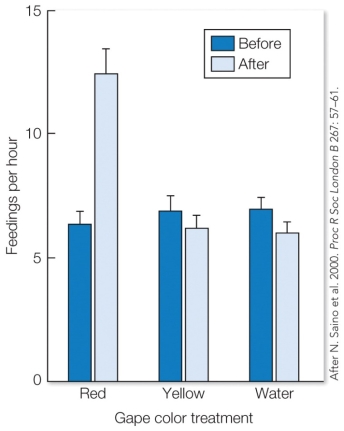 If natural gape coloring is hereditary, this experiment was most likely to test the prediction that
If natural gape coloring is hereditary, this experiment was most likely to test the prediction that
A) parents preferentially feed offspring with bright red mouths because they are investing in nestlings of high reproductive value.
B) parents preferentially feed offspring with bright red mouths because they use this as signature to recognize the chicks as their own.
C) parents in low quality habitats preferentially feed red-mouthed male offspring because they are more likely to disperse.
D) parents preferentially feed older offspring with more developed red mouths in order to facilitate facultative siblicide.
 If natural gape coloring is hereditary, this experiment was most likely to test the prediction that
If natural gape coloring is hereditary, this experiment was most likely to test the prediction thatA) parents preferentially feed offspring with bright red mouths because they are investing in nestlings of high reproductive value.
B) parents preferentially feed offspring with bright red mouths because they use this as signature to recognize the chicks as their own.
C) parents in low quality habitats preferentially feed red-mouthed male offspring because they are more likely to disperse.
D) parents preferentially feed older offspring with more developed red mouths in order to facilitate facultative siblicide.

Unlock Deck
Unlock for access to all 22 flashcards in this deck.
Unlock Deck
k this deck
9
Refer to the figure, which shows the provisioning efficiency of female red mason bees. 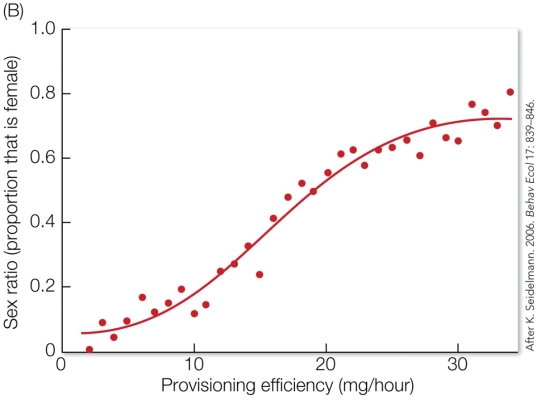 These findings indicate that
These findings indicate that
A) females have a higher provisioning efficiency than males.
B) in the beginning of the season the sex ratio of offspring is skewed male, but by the end of the season the sex ratio is biased towards females.
C) at lower provisioning efficiency, the sex ratio of offspring is skewed male, but at higher provisioning efficiency, the sex ratio is biased towards females.
D) females that are able to provision more efficiently are more likely to produce sons than daughters.
 These findings indicate that
These findings indicate thatA) females have a higher provisioning efficiency than males.
B) in the beginning of the season the sex ratio of offspring is skewed male, but by the end of the season the sex ratio is biased towards females.
C) at lower provisioning efficiency, the sex ratio of offspring is skewed male, but at higher provisioning efficiency, the sex ratio is biased towards females.
D) females that are able to provision more efficiently are more likely to produce sons than daughters.

Unlock Deck
Unlock for access to all 22 flashcards in this deck.
Unlock Deck
k this deck
10
Refer to the figure, which shows the provisioning efficiency of female red mason bees.
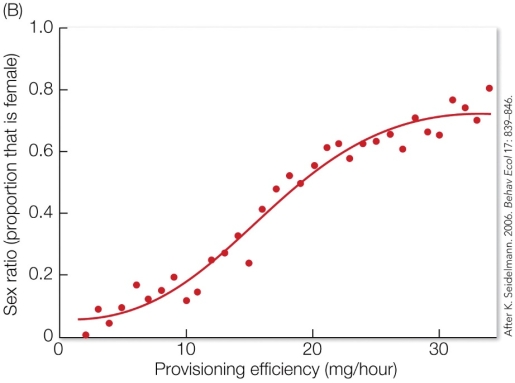 These results suggest that
These results suggest that
A) females invest more in sons because they have higher reproductive value.
B) when resources are limited, females invest more in sons because they are more likely to disperse.
C) lower quality females invest more in daughters because they are the cheaper sex to produce.
D) females adjust which sex they produce according to their body condition and ability to gather resources.
 These results suggest that
These results suggest thatA) females invest more in sons because they have higher reproductive value.
B) when resources are limited, females invest more in sons because they are more likely to disperse.
C) lower quality females invest more in daughters because they are the cheaper sex to produce.
D) females adjust which sex they produce according to their body condition and ability to gather resources.

Unlock Deck
Unlock for access to all 22 flashcards in this deck.
Unlock Deck
k this deck
11
Refer to the figure.
 These results show the occurrence of nest predation by cowbirds on prothonotary warblers. After cowbirds laid an egg in the nest, the nests were divided into three treatments:
These results show the occurrence of nest predation by cowbirds on prothonotary warblers. After cowbirds laid an egg in the nest, the nests were divided into three treatments:
1) The cowbird egg was removed, and the nest opening left as is.
2) The cowbird egg and the nest entrance were left as is.
3) The cowbird egg was removed, and the nest opening was made smaller to prevent cowbirds from entering.
These results show that
A) cowbirds repeatedly parasitize nests that they can easily access.
B) cowbirds retaliate against hosts if they discover their egg has been destroyed.
C) cowbird predation did not significantly impact the reproductive success of the warblers.
D) the presence of a parasitic chick significantly reduced survival of the warbler chicks.
 These results show the occurrence of nest predation by cowbirds on prothonotary warblers. After cowbirds laid an egg in the nest, the nests were divided into three treatments:
These results show the occurrence of nest predation by cowbirds on prothonotary warblers. After cowbirds laid an egg in the nest, the nests were divided into three treatments:1) The cowbird egg was removed, and the nest opening left as is.
2) The cowbird egg and the nest entrance were left as is.
3) The cowbird egg was removed, and the nest opening was made smaller to prevent cowbirds from entering.
These results show that
A) cowbirds repeatedly parasitize nests that they can easily access.
B) cowbirds retaliate against hosts if they discover their egg has been destroyed.
C) cowbird predation did not significantly impact the reproductive success of the warblers.
D) the presence of a parasitic chick significantly reduced survival of the warbler chicks.

Unlock Deck
Unlock for access to all 22 flashcards in this deck.
Unlock Deck
k this deck
12
Refer to the figure.
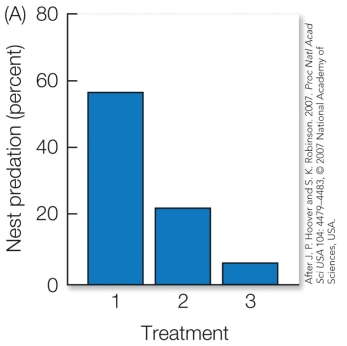 These results show the occurrence of nest predation by cowbirds on prothonotary warblers. After cowbirds laid an egg in the nest, the nests were divided into three treatments:
These results show the occurrence of nest predation by cowbirds on prothonotary warblers. After cowbirds laid an egg in the nest, the nests were divided into three treatments:
1) The cowbird egg was removed, and the nest opening left as is.
2) The cowbird egg and the nest entrance were left as is.
3) The cowbird egg was removed, and the nest opening was made smaller to prevent cowbirds from entering.
What hypothesis do these results support?
A) The mafia hypothesis.
B) The gradualist shift hypothesis.
C) The local competition hypothesis.
D) The signal of quality hypothesis.
 These results show the occurrence of nest predation by cowbirds on prothonotary warblers. After cowbirds laid an egg in the nest, the nests were divided into three treatments:
These results show the occurrence of nest predation by cowbirds on prothonotary warblers. After cowbirds laid an egg in the nest, the nests were divided into three treatments:1) The cowbird egg was removed, and the nest opening left as is.
2) The cowbird egg and the nest entrance were left as is.
3) The cowbird egg was removed, and the nest opening was made smaller to prevent cowbirds from entering.
What hypothesis do these results support?
A) The mafia hypothesis.
B) The gradualist shift hypothesis.
C) The local competition hypothesis.
D) The signal of quality hypothesis.

Unlock Deck
Unlock for access to all 22 flashcards in this deck.
Unlock Deck
k this deck
13
Bright red inner mouths in chicks indicate the level of carotenoid pigments in the chicks' diets. How does the signal of quality hypothesis explain why parents might feed these chicks more than their paler-mouthed siblings?

Unlock Deck
Unlock for access to all 22 flashcards in this deck.
Unlock Deck
k this deck
14
Assume that the red mouth coloring in chicks is hereditary and not dietary; what might be a different ultimate explanation for why parents preferentially feed red-mouthed chicks?

Unlock Deck
Unlock for access to all 22 flashcards in this deck.
Unlock Deck
k this deck
15
Explain the parent-offspring conflict in siblicide behavior. In species such as the Nazca booby, why do females lay a second egg if they tolerate high siblicide rates?

Unlock Deck
Unlock for access to all 22 flashcards in this deck.
Unlock Deck
k this deck
16
Is parental care more likely in birds with high adult mortality or low adult mortality? Why is this the case, and what evidence can you provide to support your answer?

Unlock Deck
Unlock for access to all 22 flashcards in this deck.
Unlock Deck
k this deck
17
Refer to the figure.
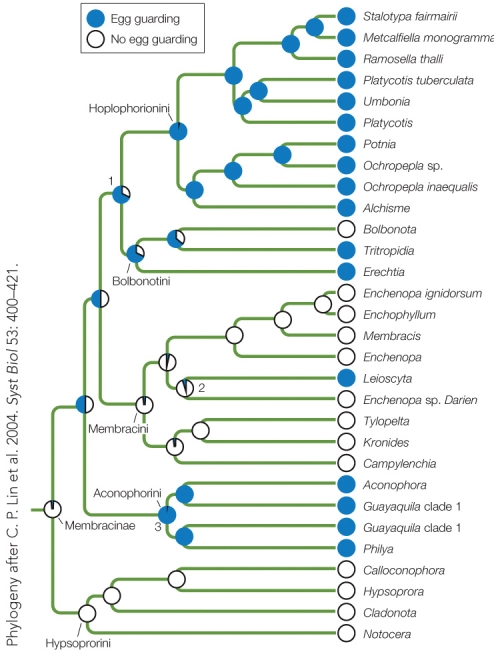 It is hypothesized that egg guarding evolved in treehoppers three times (labelled 1, 2, and 3). Imagine if the trait actually appeared in the ancestral population at the base of the tree, labelled Membracinae. What is the minimum number of trait changes that would be necessary to produce the presence of egg guarding depicted in the tree?
It is hypothesized that egg guarding evolved in treehoppers three times (labelled 1, 2, and 3). Imagine if the trait actually appeared in the ancestral population at the base of the tree, labelled Membracinae. What is the minimum number of trait changes that would be necessary to produce the presence of egg guarding depicted in the tree?
 It is hypothesized that egg guarding evolved in treehoppers three times (labelled 1, 2, and 3). Imagine if the trait actually appeared in the ancestral population at the base of the tree, labelled Membracinae. What is the minimum number of trait changes that would be necessary to produce the presence of egg guarding depicted in the tree?
It is hypothesized that egg guarding evolved in treehoppers three times (labelled 1, 2, and 3). Imagine if the trait actually appeared in the ancestral population at the base of the tree, labelled Membracinae. What is the minimum number of trait changes that would be necessary to produce the presence of egg guarding depicted in the tree?
Unlock Deck
Unlock for access to all 22 flashcards in this deck.
Unlock Deck
k this deck
18
Considering the costs and benefits to both sexes, when is male parental care more likely to evolve?

Unlock Deck
Unlock for access to all 22 flashcards in this deck.
Unlock Deck
k this deck
19
Why are parent birds more likely to be able to discriminate among chicks and find their own offspring (often with 80 percent or higher accuracy) in social species compared to solitary nesters?

Unlock Deck
Unlock for access to all 22 flashcards in this deck.
Unlock Deck
k this deck
20
In some colonial, ground-nesting gulls, young birds sometimes leave their natal nests if they have been poorly fed. On occasion, these chicks move to the nests of adults that aren't their parents. Researchers found the following:
Gull chicks that abandoned their natal nests weighed much less on average for chicks their age.
If, however, gull chicks were adopted by nonrelatives, they weighed more on average than unadopted gull chicks.
Adopted chicks are more likely to survive than chicks that remained in natal nests that failed to supply enough food.
Parents that adopted nonrelative chicks lost 0.5 chicks of their own on average.
Less than 10 percent of adult gulls take in a nonrelative chick.
These data were collected to test a hypothesis. What is likely to have been that hypothesis? Was it proximate or ultimate?
Gull chicks that abandoned their natal nests weighed much less on average for chicks their age.
If, however, gull chicks were adopted by nonrelatives, they weighed more on average than unadopted gull chicks.
Adopted chicks are more likely to survive than chicks that remained in natal nests that failed to supply enough food.
Parents that adopted nonrelative chicks lost 0.5 chicks of their own on average.
Less than 10 percent of adult gulls take in a nonrelative chick.
These data were collected to test a hypothesis. What is likely to have been that hypothesis? Was it proximate or ultimate?

Unlock Deck
Unlock for access to all 22 flashcards in this deck.
Unlock Deck
k this deck
21
In some colonial, ground-nesting gulls, young birds sometimes leave their natal nests if they have been poorly fed. On occasion, these chicks move to the nests of adults that aren't their parents. Researchers found the following:
Gull chicks that abandoned their natal nests weighed much less on average for chicks their age.
If, however, gull chicks were adopted by nonrelatives, they weighed more on average than unadopted gull chicks.
Adopted chicks are more likely to survive than chicks that remained in natal nests that failed to supply enough food.
Parents that adopted nonrelative chicks lost 0.5 chicks of their own on average.
Less than 10 percent of adult gulls take in a nonrelative chick.
Explain why gull parents might be willing to adopt the offspring of other gulls?
Gull chicks that abandoned their natal nests weighed much less on average for chicks their age.
If, however, gull chicks were adopted by nonrelatives, they weighed more on average than unadopted gull chicks.
Adopted chicks are more likely to survive than chicks that remained in natal nests that failed to supply enough food.
Parents that adopted nonrelative chicks lost 0.5 chicks of their own on average.
Less than 10 percent of adult gulls take in a nonrelative chick.
Explain why gull parents might be willing to adopt the offspring of other gulls?

Unlock Deck
Unlock for access to all 22 flashcards in this deck.
Unlock Deck
k this deck
22
Describe the two hypotheses for the evolution of specialized interspecific brood parasitism, and provide one piece of evidence supporting each.

Unlock Deck
Unlock for access to all 22 flashcards in this deck.
Unlock Deck
k this deck



